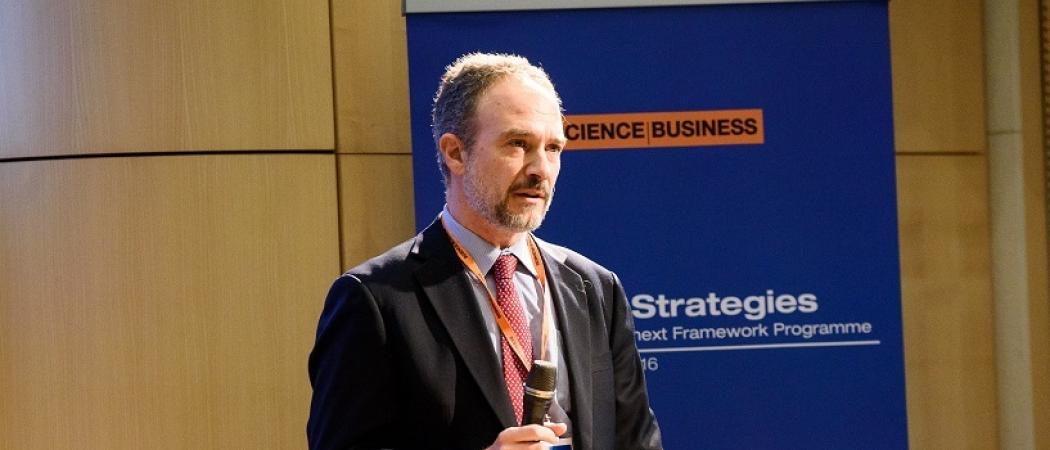The Commission turned to expert foresight analysis to help it design its next big research programme for the 2020s. Nikos Kastrinos, who led the study, describes how it worked

Nikos Kastrinos is team leader for foresight at DG Research and Innovation, European Commission
All views expressed in this article are of the author and do not necessarily reflect the views of the European Commission, or engage it in any manner.
When planning a long-range research and innovation programme like Horizon Europe, it helps to reflect on what the future might be like. Will we be struggling with devastating climate change in the 2020s? Will gene-splicing technologies be producing products, for good or ill, in the marketplace? Will the world be more unified?
For the first time, in preparing Horizon Europe, the Commission engaged in extensive, systematic and multi-year foresight to reflect on such questions. Doing so was a commitment of the Innovation Union Initiative of the Europe 2020 Strategy.
Even before work on Horizon Europe began, Baron Peter Piot, the scientist who co-discovered the Ebola virus and fora time chairman of an EU expert group, the European Forum for Forward Looking Activities (EFFLA), had been critical of the lack of foresight in the preparation of Horizon 2020.
Based on the recommendations of EFFLA, the Directorate General for Research and Innovation established a foresight hub supporting an internal network across all Commission departments. The network has been the main interface with the BOHEMIA study, an important European foresight project launched 2 years ago, to support the preparation of Horizon Europe.
Two years later, the BOHEMIA study has been completed – you can read it here. And the proposal for Horizon Europe was published June 7th. We can now ask: has foresight made a tangible difference?
The BOHEMIA study
The BOHEMIA study involved three phases which were set-out to provide analyses and intelligence according to the needs of the EU policy cycle.
The first phase of the BOHEMIA study aimed to provide a substantiated overall vision for the usefulness of European Union research and innovation in relation to the long term challenges faced by Europe and the world. This phase provided evidence to the expert group chaired by Pascal Lamy, former head of theWorld Trade Organisation, on maximising the impact of EU research and innovation programmes.
The second phase of the study used a Delphi survey – a standard tool to gather expert opinions - to offer more detailed insights into future trends in science and technology, society and policy. It built a library of expert forecasts and arguments that has been used extensively to discuss research and innovation agendas between the services of the European Commission, especially in relation to ideas on how to implement the directions of the Lamy Group.
The third phase of the study used the results of the Delphi survey to develop a number of future scenarios relating to likely disruptive technological and social trends. The study carried out an open public consultation on the implications of these scenarios for EU R&I policy. The recommendations of the public consultation have been used to critique and strengthen the directions proposed in the pillar “global challenges and industry competitiveness” of Horizon Europe.
How was the BOHEMIA study used?
The first phase of the BOHEMIA study contributed directly to the vision of an EU research and innovation policy placing Europe in a leadership position in the pursuit of the Sustainable Development Goals of the UN Agenda 2030.
Vision was needed as a counterweight for inertia. Horizon 2020 was a highly successful programme, enjoying 78 per cent approval ratings amongst stakeholders; and Horizon Europe is an evolution – not a revolution. But there are directions in this evolution and these directions combine a critique of our past with visions for our future.
The visions of the global challenges in Horizon Europe do not come straight out of the BOHEMIA study. The vision underpinning a policy is fundamentally a political question that cannot be resolved by a foresight study. But, the visions generated by the foresight exercise played a crucial role as conversation starters. The BOHEMIA study provided a view of four areas of transitions required for a world that fulfils the UN Sustainable Development Goals. This was the starting point for the discussions between the different policies that led to the clusters ultimately proposed in Horizon Europe.
Once the framing was agreed, the foresight was used to “future-proof” the proposal for Horizon Europe. This does not mean that Horizon Europe already addresses all possible surprises that the future may be holding. It means however that two important questions have been explicitly addressed in the process of preparing the proposal:
- Have all possible areas of research and innovation that have European added value been considered by the process?
- Have we considered all the likely futures pointed out by the Delphi survey and all the consensual recommendations provided by the public consultation?
The first question is of course a red herring; the answer cannot be “yes”. One reason is that there will always be more innovations possible in the future than we can currently foresee. And there will always be gaps and unknown unknowns. But simply asking the question opens up the agenda to new possibilities and to views that do not reflect the structure of the organization. And the foresight process gives rise to such new possibilities.
The second question is one that we are forced to answer positively. This does not mean that all the recommendations have been followed or included. It means, though, that we had to justify our choices as compared to the alternatives brought up in the foresight process.
While the foresight process was not the only input, and possibly not the determinant input in the development of Horizon Europe, it made a difference. It brought vision, reflexivity and engagement in the policy-making process, and for that I believe that the proposal for Horizon Europe is better than it would have been without foresight.
Is there a future for foresight in Horizon Europe?
The Commission's proposal for Horizon Europe contains provisions for foresight studies as well as provisions for shared foresight with Member States, aiming to support R&I policy making. It also places a great deal of importance on continuing strategic planning, shared governance and processes of co-design and stakeholder involvement that would benefit massively from foresight.
Key messages from the BOHEMIA foresight study:
EU R&I policies need to be transformative.
The challenges of the future require not only higher R&D investments, but also systemic transitions that will ensure a strong Europe in a sustainable world. A Europe that is able to protect, empower and defend, but also able to lead the world towards sustainability. EU R&I should become the engine of European and global transitions.
Anticipation and preparedness needs to be at the heart of EU R&I policy. EU R&I should not only generate innovations that do not exist in market. It should anticipate and prepare for changes in science, technology and innovation, in society, the economy and politics.
Likely, aspirational and disruptive future scenarios should be considered in the definition of R&I policy priorities. Evidence from analyses and from public engagement and deliberation should play a key role in the programming of EU R&I investments.
Policy experimentation is necessary in order to stimulate transitions. It is important to develop the space for policy experiments and social innovation in the junction of EU R&I and other policies of the Union.
In the future both threats and wishes may materialise. Europe should consider preparing for a wold in which:
- Assistive services and technologies such as robotic assistants, virtual trainers and small exoskeletons, are a huge economic sector.
- The expanding bioeconomy brings growth and environmental benefits.
- Energy is cheap and environmentally benign. Electricity for transport, housing and industry comes from a smart grid of novel and renewable sources
- Cybersecurity hacks proliferate. Governments build responses based on both social participation and cutting-edge technologies.
- Expert systems fed with just in time data are used routinely for the prediction and management of all kind of situations and activities.
- Medical science and public health advice have all but defeated communicable diseases.
- Emotional transparency prevails as the internet makes analysis of emotional markers more accurate and accessible to all.
- Life expectancy continues to increase as more and more human organs and tissues can be replaced without complications.
- Data analytics and robotics combine with societal participation in security to anticipate and mitigate threats.
- The EU has become a carbon neutral zone, slashing the release of greenhouse gases and expanding carbon sinks in its territory.
- Sustainable and circular consumption and production patterns make Europe more self-sufficient and competitive in its industries.
- Mature 3D printing technologies have become one of the main modes of production of finished goods.
- A new economic paradigm respects planetary boundaries and values biodiversity and natural ecosystems.
- Precision medicine anticipates and cures illnesses.
- With basic income guarantees, people work for the sense of purpose that it brings.
- Widely accessible seamless intermodal mobility services slash car ownership across the EU.
- Wide spread micro-sensors generate massive data, enabling good governance but also used for malicious purposes.
- Food is more diverse, sustainable, secure, efficient and healthy, coming from traditional agriculture as well as from novel types of supply.
- People benefit from open science, open innovation, and open education but institutions are challenged to adapt.
These likely future scenarios should be factored in EU R&I policy, which is determinant for Europe’s ability to shape the future and to benefit from it.
Read the full report at: https://ec.europa.eu/info/research-and-innovation/strategy/support-policy-making/support-eu-research-and-innovation-policy-making/foresight/activities/current/bohemia_en





 A unique international forum for public research organisations and companies to connect their external engagement with strategic interests around their R&D system.
A unique international forum for public research organisations and companies to connect their external engagement with strategic interests around their R&D system.